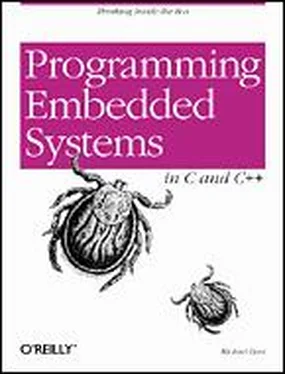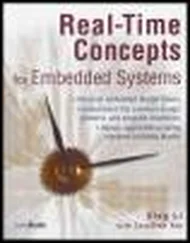Michael Barr - Programming Embedded Systems in C and C++
Здесь есть возможность читать онлайн «Michael Barr - Programming Embedded Systems in C and C++» весь текст электронной книги совершенно бесплатно (целиком полную версию без сокращений). В некоторых случаях можно слушать аудио, скачать через торрент в формате fb2 и присутствует краткое содержание. Год выпуска: 1999, ISBN: 1999, Издательство: O'Reilly, Жанр: Программирование, Компьютерное железо, на английском языке. Описание произведения, (предисловие) а так же отзывы посетителей доступны на портале библиотеки ЛибКат.
- Название:Programming Embedded Systems in C and C++
- Автор:
- Издательство:O'Reilly
- Жанр:
- Год:1999
- ISBN:1-56592-354-5
- Рейтинг книги:5 / 5. Голосов: 1
-
Избранное:Добавить в избранное
- Отзывы:
-
Ваша оценка:
- 100
- 1
- 2
- 3
- 4
- 5
Programming Embedded Systems in C and C++: краткое содержание, описание и аннотация
Предлагаем к чтению аннотацию, описание, краткое содержание или предисловие (зависит от того, что написал сам автор книги «Programming Embedded Systems in C and C++»). Если вы не нашли необходимую информацию о книге — напишите в комментариях, мы постараемся отыскать её.
Programming Embedded Systems in C and C++ — читать онлайн бесплатно полную книгу (весь текст) целиком
Ниже представлен текст книги, разбитый по страницам. Система сохранения места последней прочитанной страницы, позволяет с удобством читать онлайн бесплатно книгу «Programming Embedded Systems in C and C++», без необходимости каждый раз заново искать на чём Вы остановились. Поставьте закладку, и сможете в любой момент перейти на страницу, на которой закончили чтение.
Интервал:
Закладка:
Because production cost is so crucial in the home video game market, the designers also use tricks to shift the costs around. For example, one common tactic is to move as much of the memory and other peripheral electronics as possible off of the main circuit board and onto the game cartridges. This helps to reduce the cost of the game player, but increases the price of each and every game. So, while the system might have a powerful 64-bit processor, it might have only a few megabytes of memory on the main circuit board. This is just enough memory to bootstrap the machine to a state from which it can access additional memory on the game cartridge.
1.2.3 Mars Explorer
In 1976, two unmanned spacecraft arrived on the planet Mars. As part of their mission, they were to collect samples of the Martian surface, analyze the chemical makeup of each, and transmit the results to scientists back on Earth. Those Viking missions are amazing to me. Surrounded by personal computers that must be rebooted almost daily, I find it remarkable that more than 20 years ago a team of scientists and engineers successfully built two computers that survived a journey of 34 million miles and functioned correctly for half a decade. Clearly, reliability was one of the most important requirements for these systems.
What if a memory chip had failed? Or the software had bugs that caused it to crash? Or an electrical connection broke during impact? There is no way to prevent such problems from occurring. So, all of these potential failure points and many others had to be eliminated by adding redundant circuitry or extra functionality: an extra processor here, special memory diagnostics there, a hardware timer to reset the system if the software got stuck, and so on.
More recently, NASA launched the pathfinder mission. its primary goal was to demonstrate the feasibility of getting to Mars on a budget. Of course, given the advances in technology made since the mid-70s, the designers didn't have to give up too much to accomplish this. They might have reduced the amount of redundancy somewhat, but they still gave Pathfinder more processing power and memory than Viking ever could have. The Mars Pathfinder was actually two embedded systems: a landing craft and a rover. The landing craft had a 32-bit processor and 128 MB of RAM; the rover, on the other hand, had only an 8-bit processor and 512KB. These choices probably reflect the different functional requirements of the two systems. But I'm sure that production cost wasn't much of an issue in either case.
1.3 C: The Least Common Denominator
One of the few constants across all these systems is the use of the C programming language. More than any other, C has become the language of embedded programmers. This has not always been the case, and it will not continue to be so forever. However, at this time, C is the closest thing there is to a standard in the embedded world. In this section I'll explain why C has become so popular and why I have chosen it and its descendent C++ as the primary languages of this book.
Because successful software development is so frequently about selecting the best language for a given project, it is surprising to find that one language has proven itself appropriate for both 8-bit and 64-bit processors; in systems with bytes, kilobytes, and megabytes of memory; and for development teams that consist of from one to a dozen or more people. Yet this is precisely the range of projects in which C has thrived.
Of course, C is not without advantages. It is small and fairly simple to learn, compilers are available for almost every processor in use today, and there is a very large body of experienced C programmers. In addition, C has the benefit of processor-independence, which allows programmers to concentrate on algorithms and applications, rather than on the details of a particular processor architecture. However, many of these advantages apply equally to other high-level languages. So why has C succeeded where so many other languages have largely failed?
Perhaps the greatest strength of C — and the thing that sets it apart from languages like Pascal and FORTRAN — is that it is a very "low-level" high-level language. As we shall see throughout the book, C gives embedded programmers an extraordinary degree of direct hardware control without sacrificing the benefits of high-level languages. The "low-level" nature of C was a clear intention of the language's creators. In fact, Kernighan and Ritchie included the following comment in the opening pages of their book The C Programming Language :
C is a relatively "low level" language. This characterization is not pejorative; it simply means that C deals with the same sort of objects that most computers do. These may be combined and moved about with the arithmetic and logical operators implemented by real machines.
Few popular high-level languages can compete with C in the production of compact, efficient code for almost all processors. And, of these, only C allows programmers to interact with the underlying hardware so easily.
1.3.1 Other Embedded Languages
Of course, C is not the only language used by embedded programmers. At least three other languages — assembly, C++, and Ada — are worth mentioning in greater detail.
In the early days, embedded software was written exclusively in the assembly language of the target processor. This gave programmers complete control of the processor and other hardware, but at a price. Assembly languages have many disadvantages, not the least of which are higher software development costs and a lack of code portability. In addition, finding skilled assembly programmers has become much more difficult in recent years. Assembly is now used primarily as an adjunct to the high-level language, usually only for those small pieces of code that must be extremely efficient or ultra-compact, or cannot be written in any other way.
C++ is an object-oriented superset of C that is increasingly popular among embedded programmers. All of the core language features are the same as C, but C++ adds new functionality for better data abstraction and a more object-oriented style of programming. These new features are very helpful to software developers, but some of them do reduce the efficiency of the executable program. So C++ tends to be most popular with large development teams, where the benefits to developers outweigh the loss of program efficiency.
Ada is also an object-oriented language, though it is substantially different than C++. Ada was originally designed by the U.S. Department of Defense for the development of mission-critical military software. Despite being twice accepted as an international standard (Ada83 and Ada95), it has not gained much of a foothold outside of the defense and aerospace industries. And it is losing ground there in recent years. This is unfortunate because the Ada language has many features that would simplify embedded software development if used instead of C++.
1.3.2 Choosing a Language for the Book
A major question facing the author of a book like this is, which programming languages should be included in the discussion? Attempting to cover too many languages might confuse the reader or detract from more important points. On the other hand, focusing too narrowly could make the discussion unnecessarily academic or (worse for the author and publisher) limit the potential market for the book.
Certainly, C must be the centerpiece of any book about embedded programming — and this book will be no exception. More than half of the sample code is written in C, and the discussion will focus primarily on C-related programming issues. Of course, everything that is said about C programming applies equally to C++. In addition, I will cover those features of C++ that are most useful for embedded software development and use them in the later examples. Assembly language will be discussed in certain limited contexts, but will be avoided whenever possible. In other words, I will mention assembly language only when a particular programming task cannot be accomplished in any other way.
Читать дальшеИнтервал:
Закладка:
Похожие книги на «Programming Embedded Systems in C and C++»
Представляем Вашему вниманию похожие книги на «Programming Embedded Systems in C and C++» списком для выбора. Мы отобрали схожую по названию и смыслу литературу в надежде предоставить читателям больше вариантов отыскать новые, интересные, ещё непрочитанные произведения.
Обсуждение, отзывы о книге «Programming Embedded Systems in C and C++» и просто собственные мнения читателей. Оставьте ваши комментарии, напишите, что Вы думаете о произведении, его смысле или главных героях. Укажите что конкретно понравилось, а что нет, и почему Вы так считаете.












